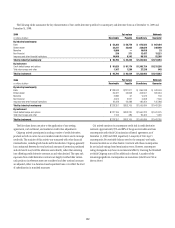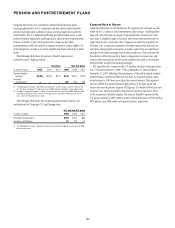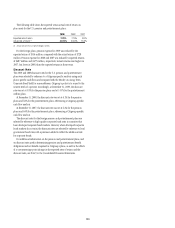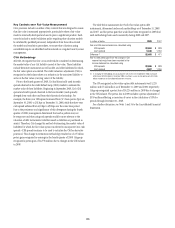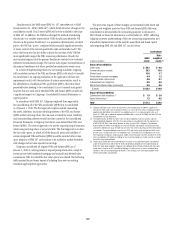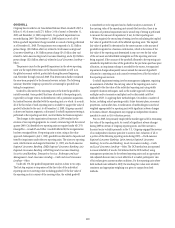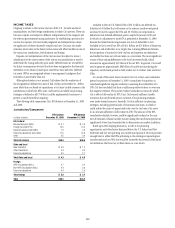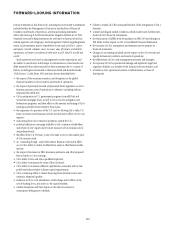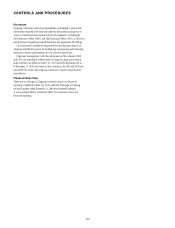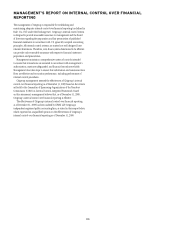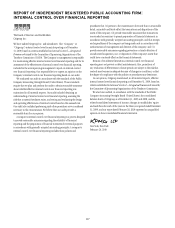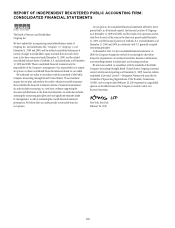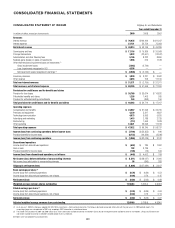Citibank 2009 Annual Report Download - page 121
Download and view the complete annual report
Please find page 121 of the 2009 Citibank annual report below. You can navigate through the pages in the report by either clicking on the pages listed below, or by using the keyword search tool below to find specific information within the annual report.111
The DCF method used at the time of each impairment test used discount
rates that Citi believes adequately reflected the risk and uncertainty in the
financial markets generally and specifically in the internally generated cash
flow projections. The DCF method employs a capital asset pricing model in
estimating the discount rate. Citi continues to value the remaining reporting
units where it believes the risk of impairment to be low, using primarily the
market approach.
Citi prepares a formal three-year strategic plan for its businesses on an
annual basis. These projections incorporate certain external economic
projections developed at the point in time the strategic plan is developed. For
the purpose of performing any impairment test, the three-year forecast is
updated by Citi to reflect current economic conditions as of the testing date.
Citi used updated long-range financial forecasts as a basis for its interim
goodwill impairment test performed as of April 1, 2009 and its annual
goodwill impairment test performed as of July 1, 2009 (as discussed below).
The 2009 Strategic Plan incorporating the most current market outlook
was the basis for the interim impairment test as of November 30, 2009 (as
discussed below).
As discussed above, management tests goodwill for impairment annually
as of July 1. The results of the July 1, 2009 test validated that the fair values
exceeded the carrying values for all reporting units. Citi is also required to
test goodwill for impairment whenever events or circumstances make it more
likely than not that impairment may have occurred, such as a significant
adverse change in the business climate, a decision to sell or dispose of all
or a significant portion of a reporting unit, or a significant decline in Citi’s
stock price. Implementation of the new organizational structure as of the
second quarter of 2009 resulted in the performance of an interim goodwill
impairment test and reallocation of goodwill among new reporting units
as of April 1, 2009. An interim goodwill impairment test for Citigroup was
performed for both the pre-reorganization reporting units and the post-
reorganization reporting units as of April 1, 2009. Results of the test indicated
no goodwill impairment for any of the pre- or post-reorganization reporting
units. Based on negative macro-economic and industry-specific factors,
Citigroup performed an additional impairment test for its Local Consumer
Lending—Cards reporting unit as of November 30, 2009. The test validated
that the fair value of the reporting unit was in excess of the associated
carrying value and, therefore, that there was no indication of goodwill
impairment.
Since none of the Company’s reporting units are publicly traded,
individual reporting unit fair value determinations cannot be directly
correlated to Citigroup’s stock price. The sum of the fair values of the
reporting units significantly exceeds the overall market capitalization of Citi.
However, Citi believes that it is not meaningful to reconcile the sum of the
fair values of the Company’s reporting units to its market capitalization
due to several factors. These factors, which do not directly impact the
individual reporting unit fair values, include the significant economic
stake and influence held by the U.S. government in Citi. In addition, the
market capitalization of Citigroup reflects the execution risk in a transaction
involving Citigroup due to its size. However, the individual reporting units’
fair values are not subject to the same level of execution risk or a business
model that is perceived to be complex.
While no impairment was noted in step one of Citigroup’s Local
Consumer Lending—Cards reporting unit impairment test at November
30, 2009, goodwill present in that reporting unit may be particularly
sensitive to further deterioration in economic conditions. Under the market
approach for valuing this reporting unit, the earnings multiples and
transaction multiples were selected from multiples obtained using data
from guideline companies and acquisitions. The selection of the actual
multiple considers operating performance and financial condition
such as return on equity and net income growth of Local Consumer
Lending—Cards as compared to the guideline companies and
acquisitions. For the valuation under the income approach, Citi utilized
a discount rate that it believes reflects the risk and uncertainty related to
the projected cash flows, and selected 2012 as the terminal year.
Small deterioration in the assumptions used in the valuations, in
particular the discount-rate and growth-rate assumptions used in the
net income projections, could significantly affect Citigroup’s impairment
evaluation and, hence, results. If the future were to differ adversely from
management’s best estimate of key economic assumptions, and associated
cash flows were to decrease by a small margin, Citi could potentially
experience future material impairment charges with respect to $4,683
million of goodwill remaining in our Local Consumer Lending—Cards
reporting unit. Any such charges, by themselves, would not negatively affect
Citi’s Tier 1 and Total Capital regulatory ratios, or Tier 1 Common ratio, its
Tangible Common Equity or Citi’s liquidity position.



